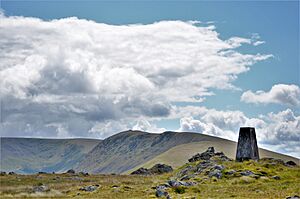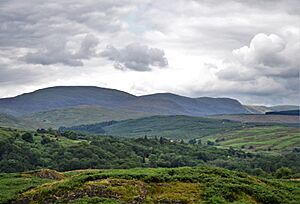Rhinns of Kells facts for kids
The Rhinns of Kells are a beautiful range of hills found in the Galloway Hills in Scotland. They are part of the larger Southern Uplands mountain range. Imagine three long lines of hills running side-by-side; the Rhinns of Kells are the most eastern one. To their west, you'll find the Range of the Awful Hand and the Dungeon Hills. These hills, along with the eastern Minnigaff Hills, are all part of the amazing Galloway Forest Park. The Rhinns of Kells are completely located within Dumfries and Galloway, a region in Scotland.
Getting to the Rhinns of Kells is usually done by car, following the A713 road which runs parallel to the hills. This road helps people reach the best starting points for walks. Two common places to begin are Garryhorn Farm, near Carsphairn, and Forrest Estate, closer to St. John's Town of Dalry. While other smaller roads exist, they are less popular because the land can be quite tricky to walk on, especially when going up or down from the south.
Because the hills form a long line, walking the entire range in one day usually means you need a ride waiting for you at the other end! For shorter trips, many people prefer circular walks that start and end at Forrest Lodge. If you don't have a car, a bus service runs from Dalmellington to Castle Douglas, passing through Carsphairn and St. John's Town of Dalry several times a day.
The Hills of the Rhinns
The Rhinns of Kells have some of the highest hills in the Galloway Hills. The tallest one is called Corserine, which reaches an impressive 814 meters (about 2,671 feet) high! Walking here often means you'll be on flat, grassy paths. However, be prepared for some muddy spots, especially after rain. The sides of the hills can be very steep and rocky. The southern part of the range, which is specifically named the Rhinns of Kells on maps, is a bit rougher to walk on.
Here are some of the main hills in the range, listed from north to south:
- Coran of Portmark (623 meters)
- Cairnsgarroch (659 meters)
- Meaul (695 meters)
- Carlin's Cairn (807 meters)
- Corserine (814 meters) - the highest!
- Millfire (716 meters)
- Milldown (738 meters)
- Meikle Millyea (748.64 meters)
Nature and Wildlife
The Rhinns of Kells are part of a special area called the Silver Flowe-Merrick Kells Biosphere Reserve. A Biosphere Reserve is a place recognized by UNESCO (a part of the United Nations) where people try to balance protecting nature with using the land in a sustainable way. This area is also a Natura 2000 site, which means it's important for protecting certain habitats and species across Europe.
The hills are a fantastic place for insects! In summer, you might see many dragonflies (called Odonata), hoverflies (which look a bit like bees but are harmless), and butterflies (called Lepidoptera).
There are several important lochs (lakes) in the area, mainly on the eastern side. These include Loch Dungeon, Loch Minnoch, and Loch Harrow. Loch Dungeon used to have a special fish called Arctic char, but they disappeared because the water became too acidic. Luckily, Brown trout survived, and the water quality has improved since then.
These lochs are also important feeding grounds for Osprey, which are large fish-eating birds of prey. There are currently ten known Osprey pairs nesting in Dumfries and Galloway. You might even spot the Lochans of Auchniebut, which are small lakes north of Meikle Millyea. At about 650 meters high, they might be the highest permanent bodies of water in the entire Southern Uplands!
What's in a Name?
The name 'Rhinns' comes from an old Irish word, rind, which means 'promontory' or 'point'. This makes sense because the hills form a long, pointed ridge.
'Kells' refers to a nearby parish (a local area) in the historic county of Kirkcudbrightshire. The name 'Kells' might come from an old Irish word, cell, meaning 'church'. However, it could also refer to the high elevation of the area or that it used to be a wooded land.
Many of the hill names come from Scottish Gaelic or Scots (a language related to English spoken in Scotland). For example, Meikle Millyea means 'large, grey, round hill'. Meikle is a Scots word for 'large', and meall liath in Scottish Gaelic means 'grey, round hill'.



